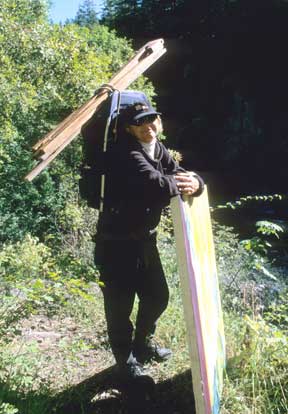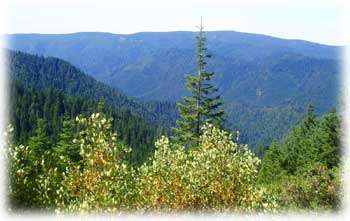|


September 1, 2005
IN
THE NEWS | PUBLISHER | ART BEAT
PREVIEW | THE HUM | CALENDAR
The Pilgrimage
 by LINDA MITCHELL by LINDA MITCHELL
It was no more than a five minute
walk, a painfully short distance, from the Doctor Rock Trailhead
to the place our guides, the detectives who investigated Ingrid
Nickelsen's death, described as her "survival nest."
Ingrid's nest was the only shady spot on this section of the
trail, a circle of earth and stones protected by a small, rocky
shelf extending out of the mountain. A young Douglas Fir grew
diagonally over this shelf, shading the nest, and small patches
of vegetation encircled it. Ingrid rested here at the end of
her long, arduous journey and continued to create. She tied fir
branches together with her shoelaces, enhancing her space, and
scribbled her final observations and wishes, with charcoal, on
the back of a trail map. Like everything Ingrid chose or created,
her nest was absolutely lovely. I touched the cool, copper-colored
soil in the place where my friend had confronted her death, with
her eyes wide open, and hoped I could do the same.
[Photo at right:
Ingrid Nickelsen. Photo by Carrie Grant.]
My companions on this pilgrimage
to Ingrid's final landscape were a small band of her family and
friends, each walking where Ingrid had walked for reasons of
their own. Some came seeking closure, I suppose, and others sought
solace. As a member of Ingrid's painting "tribe," I
was searching for a way to move beyond the circumstances of her
sad and prolonged death, and back to the joy of her life. I hoped
to discover what Ingrid had traveled here to see, the vistas
she had come here to paint.
Like many of the places Ingrid
recorded, Doctor Rock is both majestic and remote, located in
the Siskiyou Mountains, two hours northeast of Crescent City.
This is the high country, an area considered by regional Native
American tribes to be the center of the spiritual universe, a
sacred place where shamans are born. It was a perfect landscape
for Ingrid, a seasoned explorer who spent a lifetime off the
beaten path, yet too far off the grid for someone as timid as
me. I suddenly recalled a conversation we'd had, back in June,
when our tribe had last gathered at the Ranch. "I would
never do what you do," I said, referring to Ingrid's solo
treks into wild areas. "Never say never, Linda," she
answered.
We continued following Ingrid's
path, and I adjusted my pace to the unpredictable trail, which
rose and fell, widened and narrowed, as it crawled around the
mountain. The air was hot and thin. Along the way, Ed Fleshman
and Bill Stevens, our burly young detectives, pointed out the
evidence of Ingrid's effort to endure. They showed us where her
body was recovered, a few feet outside her nest, and where her
painting gear had been found, a mile and a half further along
the trail, close to where she'd fallen on the first day of August.
They pointed out the "drag marks" Ingrid left behind,
after that devastating fall, as she inched her way, day after
day, toward her truck and her supplies, back at the trailhead.
Our guides were gentle, yet unflinchingly direct: Ingrid was
really hurt. She shattered her ankle and threw out both hips.
She couldn't walk. She tried really hard, but she ran out of
water. "I struggled with how honest we should be,"
Ed said later. "But then I decided she'd want us to tell
the truth." Yes, of course, I thought. Ingrid believed,
above all else, in integrity.
Our detectives, like all those
who hear her story, are touched by Ingrid's final days, humbled
by the nobility of her struggle. They explained how Ingrid had
used the frame of her backpack as a sort of crutch to propel
herself forward, and how she'd created a splint for her ankle
with another section of the pack, anchored by one of her paintbrushes.
"Seeing that paintbrush ... wow ... it really got to me,"
Ed recalled. He shook his head, looking away.
 "In this line of work, you try not to get
too emotionally involved, but this one felt personal," Bill
observed. "We aren't always dealing with people who seem
like they're just really decent." The detectives told of
entering Ingrid's house in Eureka, in search of phone numbers
to notify her next of kin. I imagined them there, surrounded
by her exuberant garden, her quirky, colorful decor, and her
monumentally expressive oil paintings. "When we saw her
paintings, we kind of felt like we got to know her," Bill
added. "She was really something." "In this line of work, you try not to get
too emotionally involved, but this one felt personal," Bill
observed. "We aren't always dealing with people who seem
like they're just really decent." The detectives told of
entering Ingrid's house in Eureka, in search of phone numbers
to notify her next of kin. I imagined them there, surrounded
by her exuberant garden, her quirky, colorful decor, and her
monumentally expressive oil paintings. "When we saw her
paintings, we kind of felt like we got to know her," Bill
added. "She was really something."
Photo at left:
View of Ingrid's final landscape.
Photo by Linda Mitchell.
Ingrid's passion for painting
the natural world was, of course, what drew us together and cemented
our friendship. We gathered with a group of women artists each
year, to work and laugh and play in another majestic landscape,
a remote ranch on the Mad River, under the Iaqua Buttes. Ingrid
dubbed our group her "plein air tribe," trying to define
a kinship, a level of understanding that's impossible to describe.
At 62, Ingrid was an elder in our tribe, a fiercely independent
free spirit whose stories about the mysteries of the wild fueled
our imaginations and challenged us to heed our dreams.
Like Ingrid, the other artists
in our tribe find inspiration in nature and are willing to take
measured risks for an opportunity to explore and share our vision,
yet few of us have ventured as far afield as our beloved Ingrid
dared to go, in her solitary pursuit of vistas expansive enough
to satisfy her spirit. As a devoted plein air painter, Ingrid
knew better than anyone that nature has a dark side, always lurking
in the background, waiting to pounce the instant you turn your
back. She made her peace with that darkness a long time ago,
assessing the risks with a cool head and then setting them aside,
seizing any opportunity she could find to sleep under the stars
and paint the dawn. Ingrid shared the glories of the wild with
the rest of us, communicating with original, interpretive colors
she insisted were really there, if people would only take the
time to look.
When her painting gear was found,
eighteen long days after her fall, the massive canvas Ingrid
carried into the Siskiyous remained untouched. I studied the
mountain vistas she'd journeyed here to record, those towering,
timeless forms and infinite variations of tone. I tried to imagine
which colors she might have used, had Ingrid lived to interpret
the mysteries of the Dr. Rock trail. The silence echoed.
Ingrid Nickelsen's landscapes
will be included in a Plein Air Invitational Exhibition throughout
the month of September at the Cody-Pettit Gallery, 527 4th Street,
Eureka, with an Arts Alive! opening on Sept. 3. She will also
be honored with a solo exhibition of her work at the Morris Graves
Museum in September and October of 2006.
IN
THE NEWS | PUBLISHER | ART BEAT
PREVIEW | THE HUM | CALENDAR
Comments? Write a
letter!

© Copyright 2005, North Coast Journal,
Inc.
|